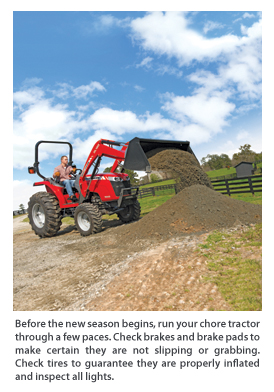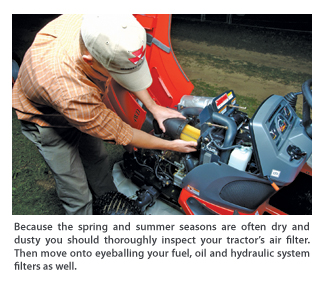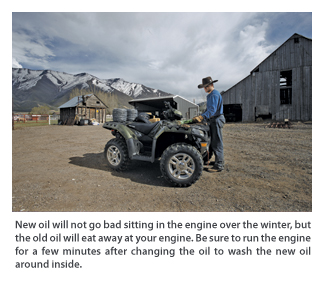Spring into Tractor Maintenance

“Starting out with a tractor that’s been fully serviced and maintained will help keep your tractor operating to its full potential when you need it to tackle tough jobs this spring and summer,” says Chris Box, marketing specialist of Compact & Commercial Equipment for Massey Ferguson. “Over the long-haul, a regular program of service and preventive maintenance to keep your tractor clean, inside and out, keeps it running smoothly, prevents costly repairs and helps maintain its resale value.”
Box offers this list for spring cleaning and preventive maintenance. Your tractor’s owner’s manual provides a detailed explanation of regular service and maintenance specific to the model you own. And, your local dealer is a resource for service, as well as genuine Original Equipment Manufactured (OEM) parts to keep your tractor running like new.
First off, begin with a thorough inspection. See if there is anything loose, damaged or in need of repair:
- Look for loose or missing nuts, bolts and screws, then tighten or replace them. Loose fasteners cause insidious damage to thread parts, linkages and bushings and loosen tolerances on tight-fitting mechanisms. Not to mention waste your time on repairs that could have been prevented.
- Make sure the bucket or other attachments are connected properly and all pins and bolts are in place.
- Look at all electrical connections and check them to see if they’re still wired tightly.
- Check for fluid leaks and worn or cracked belts. Add engine coolant and replace belts as needed.
- Check the condition of your tractor’s battery. A voltage meter reading below 9 volts indicates you need a new battery. Make sure the battery connections are tight and free of corrosion.
- Check the tires for proper air pressure and wear. Replace the tires if needed.
- Tighten wheel lugs according to the owner’s manual. Typically this is done after the first 10 hours of use and again at 50-hour intervals.
Each spring owners and operators should make these needed changes:
- Change the engine oil and filter.
- Change the fuel filter, and if the tractor has not been used for several months, drain out old fuel to prevent dirt or water that has accumulated during the winter from damaging the engine.
- Install new spark plug(s) and points.
- Replace engine and air conditioning air filters, removing any debris from these areas.
- Contact your local dealer for genuine OEM replacement parts designed and manufactured to the exact specifications of your tractor. Many OEM parts come with a 12-month warranty and are backed by the manufacturer to provide quality and reliable performance.
An un-lubricated tractor eventually experiences wear damage that will cause unnecessary and sometimes costly repairs, so be sure you lubricate this spring:
- Check your owner’s manual for grease zirk locations (so you don’t miss any) and direction on the type of grease or lubricant to use. Check the loader and other attachments as well for grease fittings.
- You also can apply a drop of lubricating oil to each nut, bolt and joint on the tractor to prevent rust and keep them from seizing up.

- Use a mild soap and water or power washer to clean away mud and debris. Automotive degreaser is an effective way to remove greasy buildup on the engine and chassis. Don’t forget the radiator screens and the underside of your tractor.
- Vacuum and wipe dust from inside the cab and wash cab windows to ensure the best view of your work.
- Give the tractor an occasional wax or polish to enhance the paint finish and add to the tractor’s resale value.
Regardless of the brand of compact tractor, your machine is an investment in your contracting fleet or perhaps your rural living experience. It’s a valued asset that with a little extra care each season can provide help and enjoyment for years to come.
Information provided by Massey Ferguson (www.masseylawn.com), based in Milwaukee, Wis.
ATV Renewal — It’s All-Terrain Tune-Up Time for Owners

Polaris, a leading manufacturer of ATVs, offers the following tips to get your vehicle in top shape before hitting the trails:
- Be sure to do a walk-around of your unit, checking air filter, coolant level, battery, tire pressure, operation of lights, tire pressure and operation of throttle and brakes. Also, check and drain fuel.
- Clean the vehicle and inspect for damage. Be sure fasteners are tight.
- After any storage period an ATV should have a complete tune-up. Call your local dealer early to beat the spring rush.
- To prevent damage to springs and blown seals caused by mud, dirt and trail debris, install shock covers. If already installed, check to make sure they are still offering full protection. If they are not, replace them.
- Don’t forget to check your protective gear, including helmet, eye gear, boots, gloves and apparel — to ensure it will offer ultimate protection.
For more information on ATVs, visit www.polarisindustries.com.


Comments are closed here.